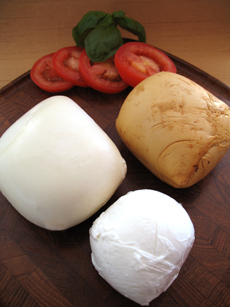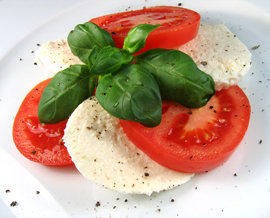
 Three fresh mozzarellas from Mozzarella Fresca. From top left: vacuum-packed, vacuum-packed smoked, and water-packed, which has the most fresh-made-this-morning-flavor. Photo by Melody Lan | THE NIBBLE. Three fresh mozzarellas from Mozzarella Fresca. From top left: vacuum-packed, vacuum-packed smoked, and water-packed, which has the most fresh-made-this-morning-flavor. Photo by Melody Lan | THE NIBBLE.
|
STEPHANIE ZONIS focuses on good foods and the people who produce them.
|
|
May 2006
Updated September 2009
|
 |
Mozzarella Cheese
Get To Know Marvelous Mozzarella
Love mozzarella? This is Page 1 of a four-page article that will make you an expert. Click on the black links below to visit other pages.
Mozzarella Overview
Mozzarella has become a culinary darling of late, and it’s about time! For too long, at least in the U.S., mozzarella was relegated to the role of second-class cheese citizen, as the good-quality stuff was available only to the lucky/knowledgeable few who lived in or near communities where the real deal was still being made. The rest of us, in our ignorance, settled for the mass-produced mimic and thought mozzarella was no big deal.
But times have changed. Fresh mozzarella is now more readily available (though you still have to be careful of this claim); it’s even possible to get the legendary mozzarella di bufala, the mozzarella made from water buffalo milk. Burrata is becoming a hot item among cheese cognoscenti. And I’ve even heard rumors of a mozzarella bar opening in the L.A. area, though to date I can’t confirm those. Let’s take a closer look at this formerly-neglected cheese.
Mozzarella History
Mozzarella’s name derives from the Italian verb “mozzare,” meaning “to cut off,” from the action of cutting the curd into smaller, less unwieldy pieces. Mozzarella production began…well, nobody knows exactly when this happened, but this cheese has been around for centuries. There appears to be a print reference to mozzarella in the twelfth century in connection with a monastery in Capua, but a better-documented reference is found in a 1570 cookbook, written by the cook of the Papal Court, Bartolomeo Scappi. Most sources indicate that mozzarella was being made sometime after the introduction of the water buffalo into the Campania area in southern Italy (although one source tells me mozzarella was made from cows’ milk before it was made from the milk of the water buffalo). And when did the water buffalo arrive in Campania? Again, no one is sure. There’s some thought that this might have happened in the sixth century C.E. (one account specifies the year 520); other historians believe that water buffalo were introduced into Italy by Hannibal, no later than around 200 B.C.E.
No matter whether you believe that mozzarella was originally a cow’s milk or buffalo’s milk cheese, regions of Italy outside of Campania didn’t often raise water buffalo, so their mozzarella would have been made with cows’ milk.
Interestingly, water buffalo milk has an advantage over cows’ milk when one is making cheese. The milk given by water buffalo is so high in fat and protein that it is too rich for many people to drink, but it is precisely this richness and quantity of protein that renders it ideal for cheesemaking.
|

Mozzarella Di Bufala imported from Italy has a
D.O.P. (Denominazione d’Origine Protetta, the Italian
and European Union certification of authenticity of
origin). |
Made from real buffalo milk, this wonderfully elastic versatile Mozzarella creates the most mouth-watering pizzas and appetizers...or in the classic Caprese salad, above, with tomato and basil. Photo of the classic Caprese salad—mozzarella, tomatoes and fresh basil—by Rose Vita.
Prior to the 1860s, mozzarella was a raw milk cheese by virtue of the fact that pasteurization had not yet been invented. Mozzarella has always been a fresh (as opposed to an aged) cheese, thus making it especially perishable. Because of this, it does not seem to have been especially common. Only the very wealthy (who could afford to pay for the cost and transport of fragile delicacies), or people who lived in or near the communities where it was made, could enjoy mozzarella. In fact, mozzarella doesn’t seem to have become widely known until the later part of the 18th century.
Continue To Page 2: Making Mozzarella Cheese
Go To The Article Index Above
Lifestyle Direct, Inc. All rights reserved. Images are the copyright of their respective owners. 
|



